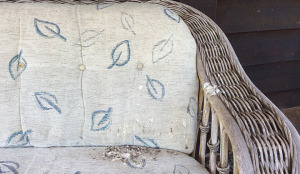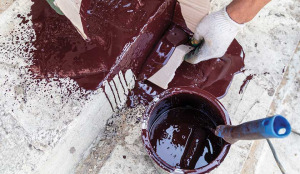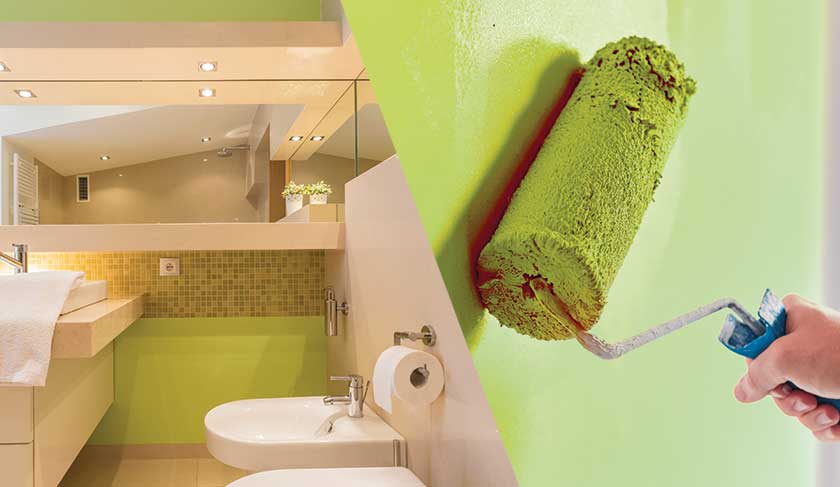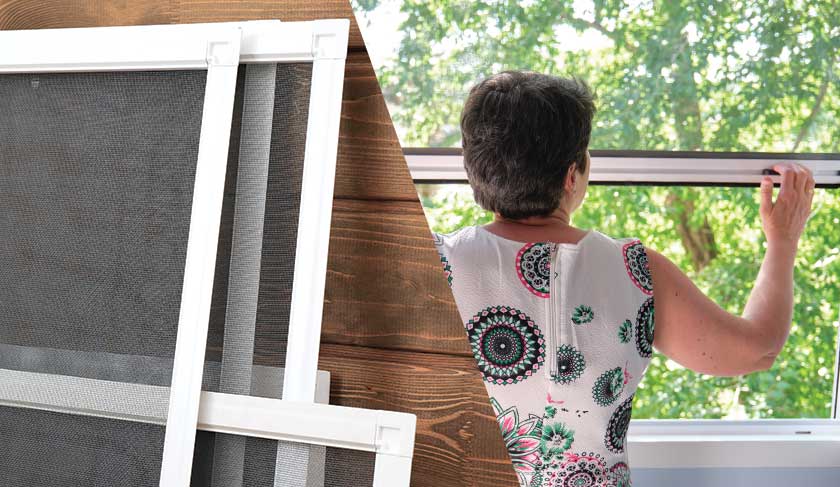Ok, you’ve finished painting your house, but now you’re left with a headful of nasty paint fumes to deal with. In this article, I explain how to get rid of the paint smell and fumes after house painting, so you and your family can rest safely.
Painting your house is a great way of sprucing it up a bit and making it look cleaner and newer. But, getting rid of those paint fumes is not an easy task, and whatever you try you probably won’t be able to remove them completely. However, we can use methods to lessen the paint smell and reduce the length of time that the fumes stick around.
In our earlier article on how to paint a house interior, we explained that part of the process of planning and painting a room (especially a bedroom) should to be make arrangements to sleep somewhere else that night. This is the only surefire way to avoid breathing in the fumes over an extended period, however, if that is not an option, then you can resort to one of the solutions below to lessen the paint smell instead.
Next, I’ll explain how to get rid of the paint smell and fumes, at least some of them, once you have finished painting your house or room interior.

How to Get Rid of the Paint Smell & Fumes after House Painting
Choose Water-based Paint
Generally, oil-based paints are going to leave a stronger and longer lasting odor than water-based paints, something we discuss in our article on whether it is safe to paint while pregnant. If you haven’t started painting yet and the fumes are a major concern, then try to use water-based latex paints where possible, in particular one labelled as low-odor. Luckily, water-based paints are the most common type you will likely use, as these days oil-based paints are generally only used for specific applications such as painting timber or an oil-based enamel for trims.
Ventilate the Space
The first thing that you need to do as a homeowner or DIYer, is to make sure that the space is well ventilated. In fact, before you start any painting project, it’s important to open up any windows and doors in order to allow the air to flow through the room if possible. If it’s not possible, then take the time to make use of fans in order to move the air through the room and help the paint dry faster. It’s also important to turn off the home’s air-conditioning and heating in order to prevent the smells from making their way into the other rooms of the home. Also, close the doors to other rooms of your house, to prevent the paint fumes drifting throughout the entire house. I personally like to use two fans, one placed at one window facing out, and the other placed near another window facing in – I find this helps cycle air in, through and out of the room.
Use Buckets of Water
Believe it or not, one of the simplest ways of eating rid of paint smells and fumes are to simply place a bucket filled with water in the room overnight. The water itself is capable of absorbing the paint vapors, which effectively traps the odor in the water. This particular trick dates back to the early 1900s when paint began replacing whitewashing as the most popular way of adding color to a home.
Use Bowls of Vinegar
If the buckets of water are too much, then you can try filling up a few bowls with vinegar water. Vinegar is acetic acid and is known to neutralize the molecules that contain odors. Rather than placing buckets of water throughout the space, simply put a couple of bowls filled with 10% white vinegar for extremely fast results.
Try Some Baking Soda
When all else fails, you can always turn to baking soda. For years, people have used Arm and Hammer baking soda to help reduce the odors within the refrigerator. So naturally, it just makes sense that baking soda would also help to absorb the odor within a room. Granted you will need a lot more baking soda to deodorize a room than you would need for a refrigerator, but it is possible to reduce the overall odor in a matter of a few hours.
Charcoal Can Help Too
If you are in a pinch, then you are more than welcome to use regular old charcoal briquettes that are meant for cooking on the grill. While not as effective as activated charcoal, they are still capable of absorbing large volumes of paint vapors simply because of their porous structure. Simply pour the charcoal briquettes into an aluminum pan, and leave it in the room overnight. If you can get your hand on some, then activated charcoal is an excellent way of removing odors, but it’s not something you are likely to have lying around the house.
A Cut Onion Also Works
Sometimes, however, in order to get rid of one bad smell, you have to fight it with another. You will be amazed at how powerful a freshly cut onion is when it comes to getting rid of paint fumes within a room. The chemical within the onion that is responsible for the distinctive onion smell, is very effective at neutralizing the aldehydes that cause paint odors as explained by EnviroClenz.
How to Get Rid of The Smell of Spray Paint
Because of the way in which spray paint is applied, the smell of paint can consume a room within a matter of seconds. And although it is more rapid and obvious when compared to household paint, it is still possible to manage the spell of spray paint within a confined space.
Use Low-VOC Spray Paint
One of the first things to do when it comes to dealing with spray paint is to prevent the smell from occurring in the first place. Low VOC spray paint is one of the best ways to reduce and/or eliminate the odor altogether. Low VOC spray paint has low volatile organic compounds, which results in fewer fumes being released in the area. So the next time you are planning on painting, look for spray paint that states that it has low VOC, and avoid any type of oil-based paints altogether.
Try Some Lemon Water
While vinegar is excellent at reducing the overall odor of paint within a household, it is not fast enough for dealing with spray paint. One of the oldest ways of getting rid of that spray paint smell is to use slices of lemon and water. A lemon water solution is really good at absorbing the vapors from the air and removing the overall odor of the spray paint overnight.
Even Coffee Grounds Will Help
One of the most interesting ways of reducing the smell of spray paint within a confined space is to use coffee beans as well as used coffee grounds. Coffee itself has a very pungent odor and can overwhelm the senses in no time. But, it is also great at absorbing other odors within the room. If coffee grounds or coffee beans are placed in a corner of a room, they are able to absorb and eliminate odors quickly. Not only are they great at dealing with spray paint odors, but they can actually make an entire room smell a lot better in the process.
Final Tips on How to Get Rid of the Paint Smell & Fumes
Now that you’re reached the end of this piece, you should have some easy strategies you can roll out to lessen the paint odors lingering in your room. Keep in mind that there are no magic solutions here (or anywhere), and the safest option is to simply avoid entering and using the freshly painted room, especially when dealing with oil-based paints.
Chances are you have come to this article because you have already painted your house, and are desperately looking for solutions to make your house livable while the paint dries. If that’s the case, here is a quick recap of some of the best things you can do right now to get rid of the paint smell as much as possible:
- Ventilate the room. Open the windows and set-up a fan or two.
- Buckets of water. Place a couple of buckets of water in the room overnight.
- Bowls of vinegar. Place bowls of vinegar in the room overnight.
- Half-cut onions. Cut a few onions in half and place them around the room.
If on the other hand you have come to this article before you started painting, on which I applaud you for being so damn organized, then what you really should be factoring into your planning is this:
- Choose a water-based and low VOC paint where possible, as these release less fumes than oil-based paints. However, don’t let that stop you from choosing the right paint for the job. If an oil-based enamel is better for your trims, for example, then use that, but just be aware that it will produce more smell and more harmful fumes than water-based paints.
- Arrange to sleep somewhere else that night. When I painted our house interior I always arranged to do it the day before a road trip, so the house could dry undisturbed over the weekend while we were away. If that is not an option, then paint one room at a time, and sleep in the unpainted room while the other one dries (and keep the doors to the painted room closed so the fumes don’t invade the rest of the house, of course).
If you are painting a children’s room, take the safe option and don’t let them sleep in the room overnight. Children are more sensitive to everything than adults, and besides, you don’t really want to risk of them touching your wet paint!
For more tips, read our article on whether women can paint while pregnant – even if you are not pregnant or breast-feeding it has good advice on dealing with paint fumes and choosing low-odor house paints.
Good luck!
Author
-

Hey, I’m Sara, co-owner of NestKoo! I’m a graphic designer and professionally trained fine artist, with a Bachelor of Arts (Fine Art) majoring in Painting. I love being close to nature, sustainable living and bringing new life to old things. My specialty in NestKoo is DIY house painting, upholstery and furniture upcycling, where I bring my skills in fine art painting and contemporary design together into a practical home DIY context.
View all posts









